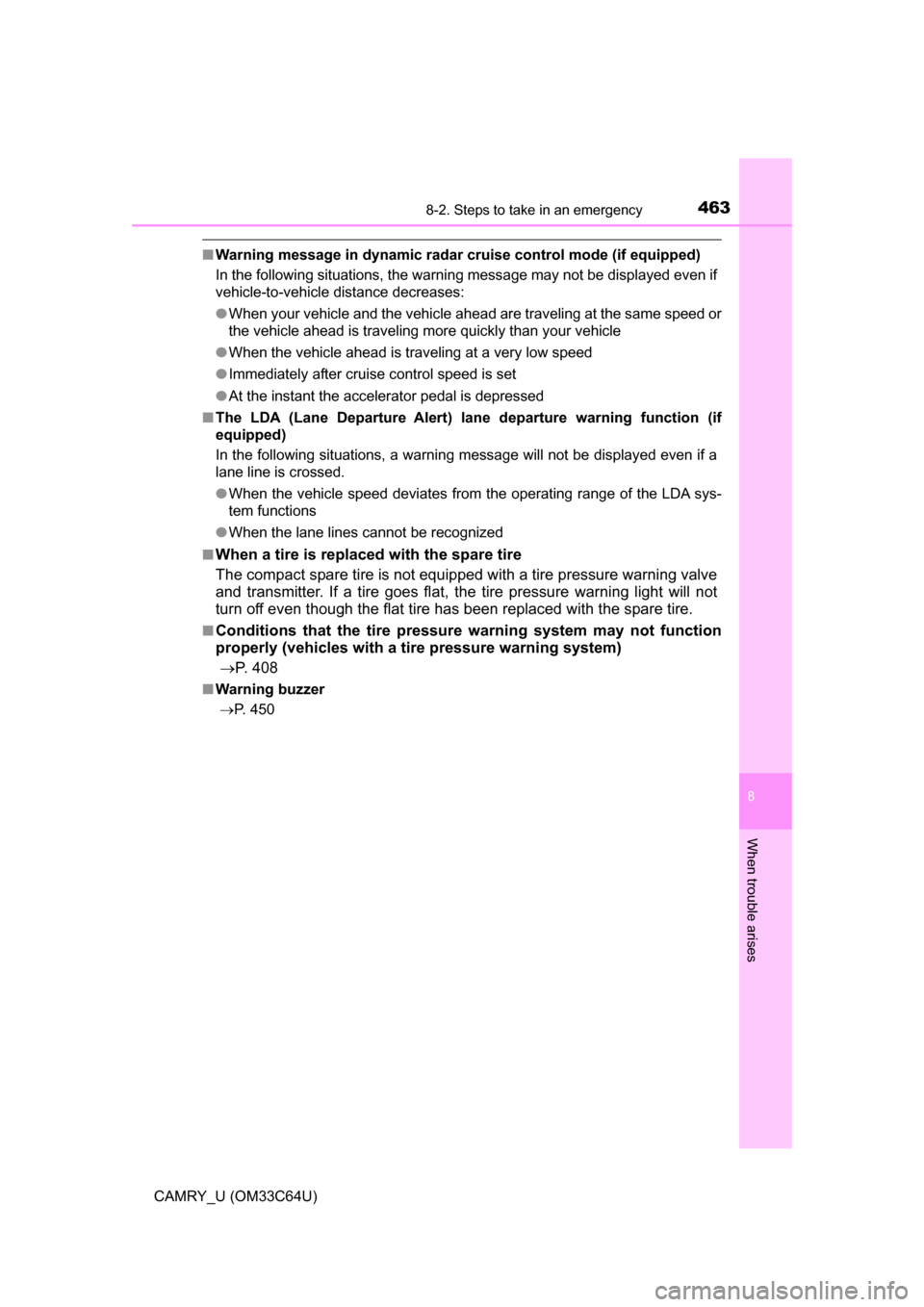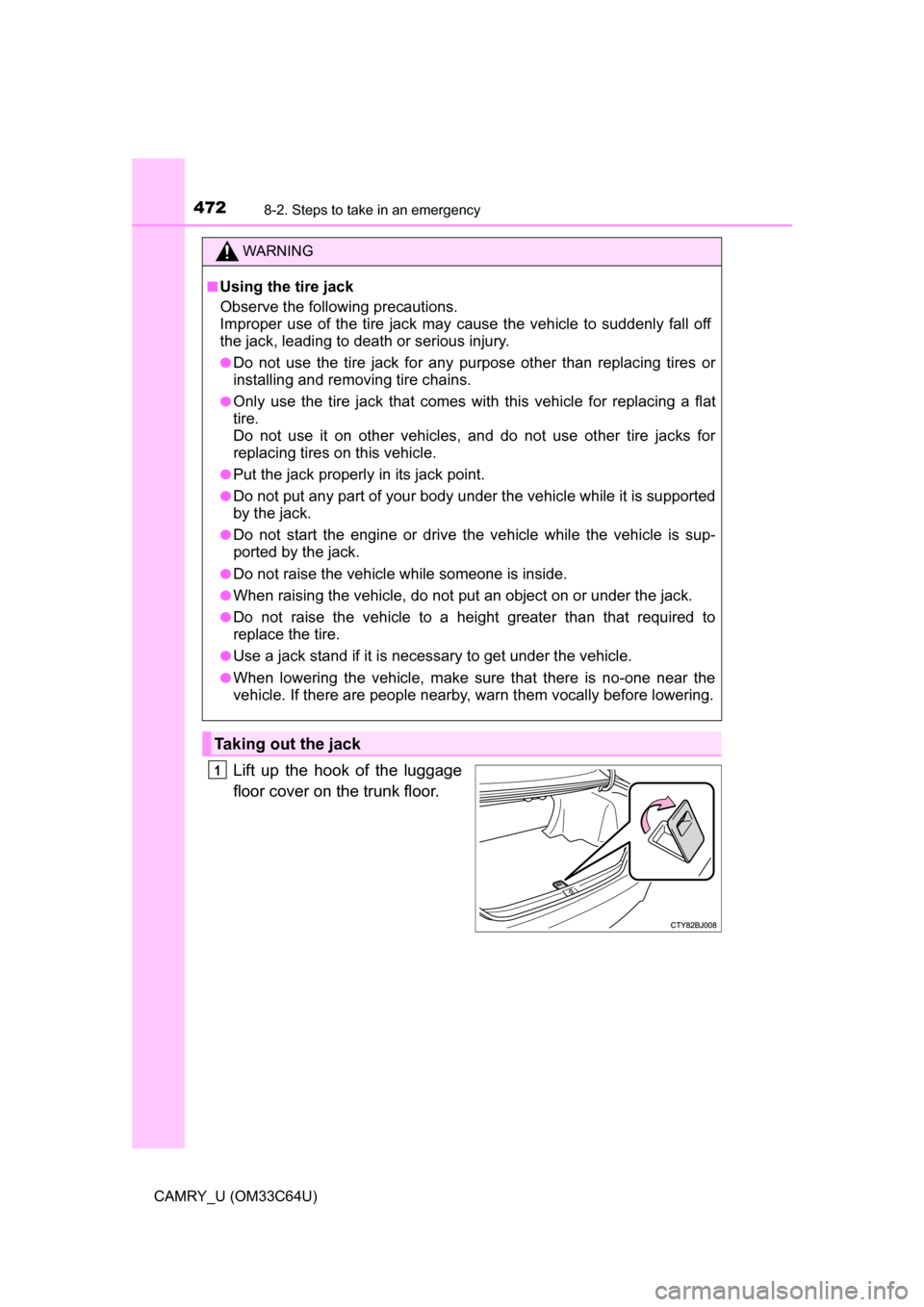Page 452 of 568

4528-2. Steps to take in an emergency
CAMRY_U (OM33C64U)
WARNING
■Maintenance of the tires
Each tire, including the spare (if provided), should be checked monthly
when cold and inflated to the inflation pressure recommended by the
vehicle manufacturer on the vehicle placard or tire inflation pressure
label (tire and load information label). (If your vehicle has tires of a dif-
ferent size than the size indicated on the vehicle placard or tire inflation
pressure label [tire and load information label], you should determine
the proper tire inflation pressure for those tires.)
As an added safety feature, your vehicle has been equipped with a tire
pressure monitoring system (TPMS-ti re pressure warning system) that
illuminates a low tire pre ssure telltale (tire pressure warning light) when
one or more of your tires is significantly under-inflated. Accordingly,
when the low tire pressure telltale (tire pressure warning light) illumi-
nates, you should stop and check your tires as soon as possible, and
inflate them to the proper pressure. Driving on a significantly under-
inflated tire causes the tire to overheat and can lead to tire failure.
Under-inflation also reduces fuel effi ciency and tire tread life, and may
affect the vehicle’s handling and stopping ability.
Please note that the TPMS (tire pressure warning system) is not a sub-
stitute for proper ti re maintenance, and it is the driver’s responsibility to
maintain correct tire pressure, even if under-inflation has not reached
the level to trigger illumination of the TPMS low tire pressure telltale (tire
pressure warning light).
Your vehicle has also been equipped with a TPMS (tire pressure warn-
ing system) malfunction indicator to indicate when the system is not
operating properly. The TPMS (tire pressure warning system) malfunc-
tion indicator is combined with the lo w tire pressure telltale (tire pressure
warning light). When the system detects a malfunction, the telltale will
flash for approximately one minute and then remain continuously illumi-
nated. This sequence will continue upon subsequent vehicle start-ups as long as the malfunction exists. When the malfunction indicator is illu-
minated, the system may not be able to detect or signal low tire pres-
sure as intended.
TPMS (tire pressure warning system) malfunctions may occur for a vari-
ety of reasons, including the installation of replacement or alternate tires
or wheels on the vehicle that prevent the TPMS (tire pressure warning
system) from functioning properly. Always check the TPMS (tire pres-
sure warning system) malfunction te lltale after replacing one or more
tires or wheels on your vehicle to ensure that the replacement or alter-
nate tires and wheels allow the TPMS (tire pressure warning system) to
continue to function properly.
Page 459 of 568
4598-2. Steps to take in an emergency
8
When trouble arises
CAMRY_U (OM33C64U)
(If equipped)
Indicates that the moon roof is not fully closed
(with the engine switch off, and the driver’s door
open)A buzzer also sounds.
Close the moon roof.
(If equipped)
Indicates a malfunction in the Automatic High
Beam system
A buzzer also sounds.
Have the vehicle inspect ed by your Toyota
dealer.
(If equipped)
Indicates that the tire inflation pressure is low
Check the tire inflation pressure, and
adjust to the appropriate level.
Warning messageDetails/Actions
(Flashes)
(Vehicles with a tire
inflation pressure dis-
play function)
Page 460 of 568

4608-2. Steps to take in an emergency
CAMRY_U (OM33C64U)
(If equipped)
Indicates a malfunction in the tire pressure
warning system
Stop the vehicle in a safe place and turn
the engine switch off then on again.
If the tire pressure warning indicator
flashes for 1 minute then illuminates,
there is a malfunction in the system.
Have the vehicle inspected at your
Toyota dealer.
(If equipped)
Indicates that the tire position information can-
not be recognized
Drive for a short while and check if the
display updates.
If the radio wave conditions improve, the
display may return to normal. If the tire
pressure is still not displayed after driv-
ing for several minutes, stop the vehicle
in a safe place, turn the engine switch off
then on again, and start driving.
If the tire pressure is still not displayed
even after repeating this process several
times, have the vehicle inspected at your
Toyota dealer.
Indicates that the washer fluid level is low
Add washer fluid.
Warning messageDetails/Actions
(Vehicles with a tire
inflation pressure dis-
play function)
(Vehicles with a tire
inflation pressure dis-
play function)
Page 463 of 568

4638-2. Steps to take in an emergency
8
When trouble arises
CAMRY_U (OM33C64U)
■Warning message in dynamic radar cr uise control mode (if equipped)
In the following situations, the warning message may not be displayed even if
vehicle-to-vehicle distance decreases:
● When your vehicle and the vehicle ahead are traveling at the same speed or
the vehicle ahead is traveling more quickly than your vehicle
● When the vehicle ahead is traveling at a very low speed
● Immediately after cruise control speed is set
● At the instant the accelerator pedal is depressed
■ The LDA (Lane Departure Alert) lane departure warning function (if
equipped)
In the following situations, a warning message will not be displayed even if a
lane line is crossed.
●When the vehicle speed deviates from the operating range of the LDA sys-
tem functions
● When the lane lines cannot be recognized
■
When a tire is replaced with the spare tire
The compact spare tire is not equipped with a tire pressure warning valve
and transmitter. If a tire goes flat, the tire pressure warning light will not
turn off even though the flat tire has been replaced with the spare tire.
■Conditions that the tire pressure warning system may not function
properly (vehicles with a tire pressure warning system)
P. 4 0 8
■Warning buzzer
P. 450
Page 470 of 568
4708-2. Steps to take in an emergency
CAMRY_U (OM33C64U)
●Stop the vehicle in a safe place on a hard, flat surface.
● Set the parking brake.
● Shift the shift lever to P.
● Stop the engine.
● Turn on the emergency flashers. ( P. 438)
If you have a flat tire
Your vehicle is equipped with a spare tire. The flat tire can be
replaced with the spare tire.
For details about tires:
P. 403
WARNING
■
If you have a flat tire
Do not continue driving with a flat tire.
Driving even a short dist ance with a flat tire can damage the tire and the
wheel beyond repair, which could result in an accident.
Before jacking up the vehicle
Page 472 of 568

4728-2. Steps to take in an emergency
CAMRY_U (OM33C64U)
Lift up the hook of the luggage
floor cover on the trunk floor.
WARNING
■Using the tire jack
Observe the following precautions.
Improper use of the tire jack may cause the vehicle to suddenly fall off
the jack, leading to death or serious injury.
●Do not use the tire jack for any purpose other than replacing tires or
installing and removing tire chains.
●Only use the tire jack that comes with this vehicle for replacing a flat
tire.
Do not use it on other vehicles, and do not use other tire jacks for
replacing tires on this vehicle.
●Put the jack properly in its jack point.
●Do not put any part of your body under the vehicle while it is supported
by the jack.
●Do not start the engine or drive the vehicle while the vehicle is sup-
ported by the jack.
●Do not raise the vehicle while someone is inside.
●When raising the vehicle, do not put an object on or under the jack.
●Do not raise the vehicle to a height greater than that required to
replace the tire.
●Use a jack stand if it is necessary to get under the vehicle.
●When lowering the vehicle, make sure that there is no-one near the
vehicle. If there are people nearby, warn them vocally before lowering.
Taking out the jack
1
Page 475 of 568
4758-2. Steps to take in an emergency
8
When trouble arises
CAMRY_U (OM33C64U)
Chock the tires.
For vehicles with steel wheels,
remove the wheel ornament
using the wrench.
To protect the wheel ornament,
place a rag between the wrench
and the wheel ornament, as
shown in the illustration.
Slightly loosen the wheel nuts
(one turn).
Replacing a flat tire
1
Flat tireWheel chock positions
FrontLeft-hand sideBehind the rear right-hand side tire
Right-hand sideBehind the rear left-hand side tire
RearLeft-hand sideIn front of the front right-hand side tire
Right-hand sideIn front of the front left-hand side tire
2
3
Page 477 of 568

4778-2. Steps to take in an emergency
8
When trouble arises
CAMRY_U (OM33C64U)
WARNING
■Replacing a flat tire
●Do not touch the disc wheels or the area around the brakes immedi-
ately after the vehicle has been driven.
After the vehicle has been driven the disc wheels and the area around
the brakes will be extremely hot. Touching these areas with hands, feet
or other body parts while changing a tire, etc. may result in burns.
●Failure to follow these precautions could cause the wheel nuts to
loosen and the tire to fall off, resulting in death or serious injury.
• Have the wheel nuts tightened with a torque wrench to 76 ft•lbf (103 N•m, 10.5 kgf•m) as soon as possible after changing wheels.
• Do not attach a heavily damaged wheel ornament, as it may fly off
the wheel while the vehicle is moving.
• When installing a tire, only use w heel nuts that have been specifi-
cally designed for that wheel.
• If there are any cracks or deforma tions in the bolt screws, nut
threads or bolt holes of the wheel, have the vehicle inspected by
your Toyota dealer.
• When installing the wheel nuts, be sure to install them with the
tapered ends facing inward. ( P. 417)